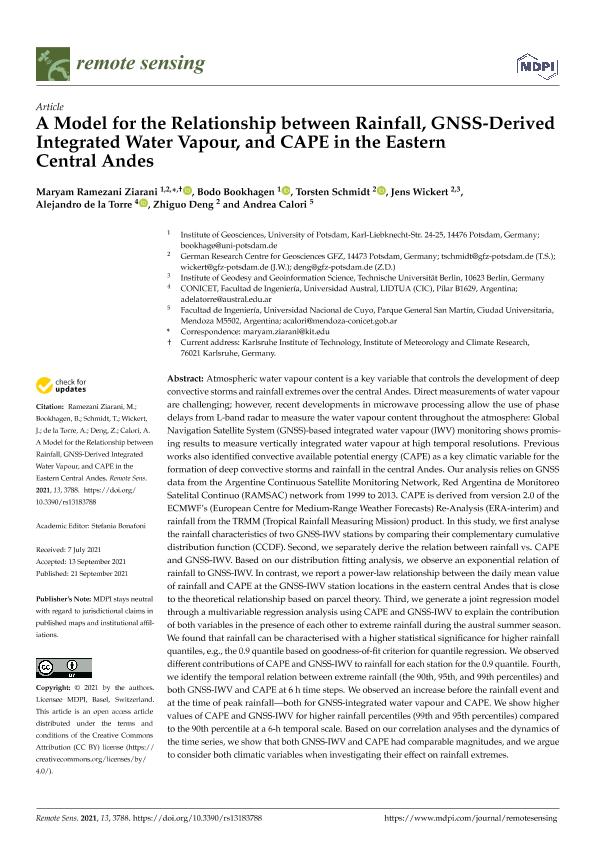Artículo
A Model for the Relationship between Rainfall, GNSS-Derived Integrated Water Vapour, and CAPE in the Eastern Central Andes
Ziarani, Maryam Ramezani; Bookhagen, Bodo; Schmidt, Torsten; Wickert, Jens; de la Torre, Alejandro ; Deng, Zhiguo; Calori, Andrea Virginia
; Deng, Zhiguo; Calori, Andrea Virginia
 ; Deng, Zhiguo; Calori, Andrea Virginia
; Deng, Zhiguo; Calori, Andrea Virginia
Fecha de publicación:
09/2021
Editorial:
Multidisciplinary Digital Publishing Institute
Revista:
Remote Sensing
e-ISSN:
2072-4292
Idioma:
Inglés
Tipo de recurso:
Artículo publicado
Clasificación temática:
Resumen
Atmospheric water vapour content is a key variable that controls the development of deep convective storms and rainfall extremes over the central Andes. Direct measurements of water vapour are challenging; however, recent developments in microwave processing allow the use of phase delays from L-band radar to measure the water vapour content throughout the atmosphere: Global Navigation Satellite System (GNSS)-based integrated water vapour (IWV) monitoring shows promising results to measure vertically integrated water vapour at high temporal resolutions. Previous works also identified convective available potential energy (CAPE) as a key climatic variable for the formation of deep convective storms and rainfall in the central Andes. Our analysis relies on GNSS data from the Argentine Continuous Satellite Monitoring Network, Red Argentina de Monitoreo Satelital Continuo (RAMSAC) network from 1999 to 2013. CAPE is derived from version 2.0 of the ECMWF’s (European Centre for Medium-Range Weather Forecasts) Re-Analysis (ERA-interim) and rainfall from the TRMM (Tropical Rainfall Measuring Mission) product. In this study, we first analyse the rainfall characteristics of two GNSS-IWV stations by comparing their complementary cumulative distribution function (CCDF). Second, we separately derive the relation between rainfall vs. CAPE and GNSS-IWV. Based on our distribution fitting analysis, we observe an exponential relation of rainfall to GNSS-IWV. In contrast, we report a power-law relationship between the daily mean value of rainfall and CAPE at the GNSS-IWV station locations in the eastern central Andes that is close to the theoretical relationship based on parcel theory. Third, we generate a joint regression model through a multivariable regression analysis using CAPE and GNSS-IWV to explain the contribution of both variables in the presence of each other to extreme rainfall during the austral summer season. We found that rainfall can be characterised with a higher statistical significance for higher rainfall quantiles, e.g., the 0.9 quantile based on goodness-of-fit criterion for quantile regression. We observed different contributions of CAPE and GNSS-IWV to rainfall for each station for the 0.9 quantile. Fourth, we identify the temporal relation between extreme rainfall (the 90th, 95th, and 99th percentiles) and both GNSS-IWV and CAPE at 6 h time steps. We observed an increase before the rainfall event and at the time of peak rainfall—both for GNSS-integrated water vapour and CAPE. We show higher values of CAPE and GNSS-IWV for higher rainfall percentiles (99th and 95th percentiles) compared to the 90th percentile at a 6-h temporal scale. Based on our correlation analyses and the dynamics of the time series, we show that both GNSS-IWV and CAPE had comparable magnitudes, and we argue to consider both climatic variables when investigating their effect on rainfall extremes.
Archivos asociados
Licencia
Identificadores
Colecciones
Articulos(SEDE CENTRAL)
Articulos de SEDE CENTRAL
Articulos de SEDE CENTRAL
Citación
Ziarani, Maryam Ramezani; Bookhagen, Bodo; Schmidt, Torsten; Wickert, Jens; de la Torre, Alejandro; et al.; A Model for the Relationship between Rainfall, GNSS-Derived Integrated Water Vapour, and CAPE in the Eastern Central Andes; Multidisciplinary Digital Publishing Institute; Remote Sensing; 13; 18; 9-2021; 1-19
Compartir
Altmétricas



